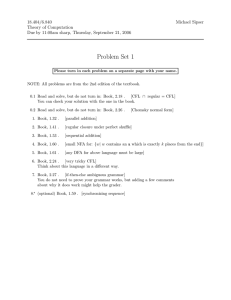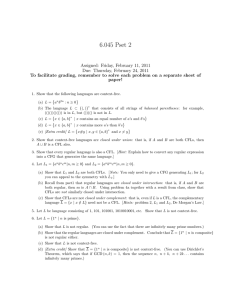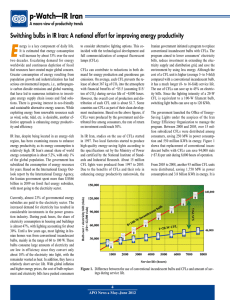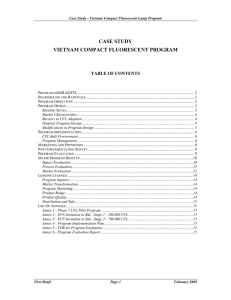Document 13936475
advertisement
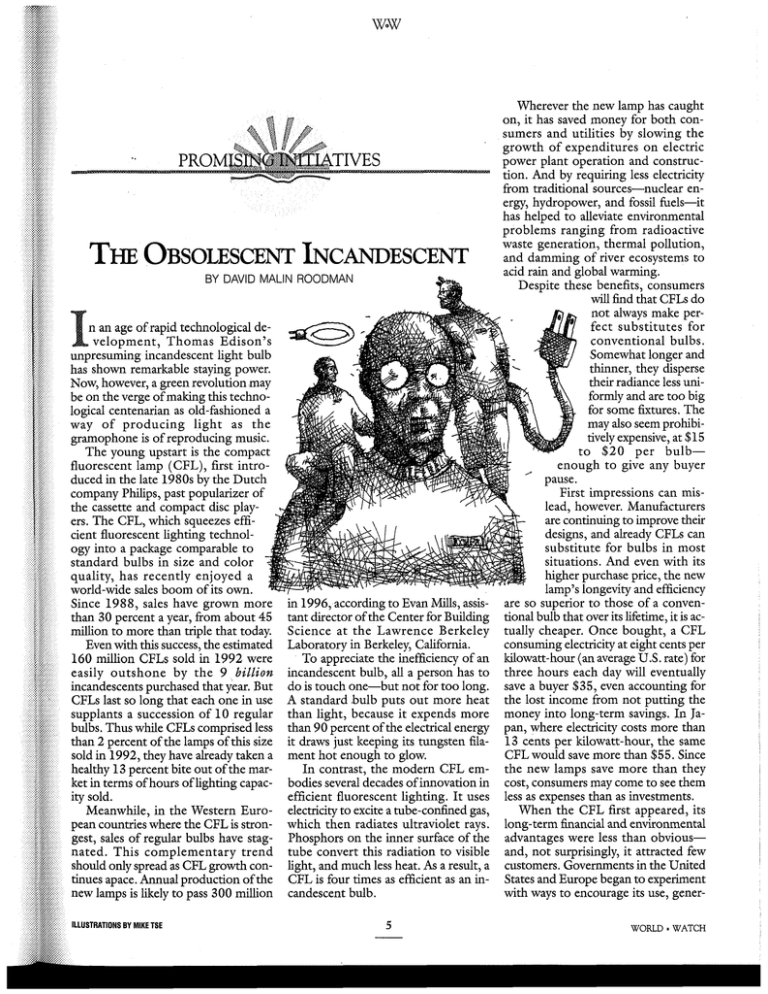
Tm OBSOLESCENT ~CANDESCENT BY DAVID MALlN ROODMAN n an age of rapid technological development, Thomas Edison's resuming incandescent light bulb has shown remarkable staying power. Now, however, a green revolution may be on the verge of making this technological centenarian as old-fashioned a way of producing light as the grarnophone is of reproducing music. The young upstart is the compact fluorescent lamp (CFL), first introduced in the late 1980s by the Dutch company Philips, past popularizer of the cassette and compact disc players. The CFL, which squeezes efficient fluorescent iighting technology into a package comparable to standard bulbs in size and color quality, has recently enjoyed a world-wide sales boom of its own. Since 1988, sales have grown more in 1996, according to Evan Mills, assisthan 30 percent a year, from about 45 tant director of the Center for Building miliion to more than triple that today. Science at the Lawrence Berkeley Even with this success, the estimated Laboratory in Berkeley, California. To appreciate the inefficiency of an 160 million CFLs sold in 1992 were easily outshone by the 9 billion incandescent bulb, al1 a person has to incandescents purchased that year. But do is touch one-but not for too long. CFLs last so long that each one in use A standard bulb puts out more heat supplants a succession of 1 0 regular than light, because it expends more bulbs. Thus while CFLs comprised less than 90 percent of the electrical energy than 2 percent of the lamps of this size it draws just keeping its tungsten filasold in 1992, they have already taken a ment hot enough to glow. In contrast, the modern CFL emhealthy 13 percent bite out of the market in terms of hours of lighting capac- bodies several decades of innovation in efficient fluorescent lighting. It uses ity sold. Meanwhile, in the Western Euro- electricity to excite a tube-confined gas, pean countries where the CFL is stron- which then radiates ultraviolet rays. gest, sales of regular bulbs have stag- Phosphors on the inner surface of the nated. This complementary trend tube convert this radiation to visible should only spread as CFL growth con- light, and much less heat. As a result, a tinues apace. Annual production of the CFL is four times as efficient as an innew lamps is likely to pass 300 million candescent bulb. ILLUSTRATIONSBY MlKE TSE Wherever the new lamp has caught on, it has saved money for both consumers and utilities by slowing the growth of expenditures on electric power plant operation and construction. And by requiring less electricity from traditional sources-nuclear energy, hydropower, and fossil fuels-it has helped to alleviate environmental problems ranging from radioactive waste generation, thermal pollution, and damming of river ecosystems to acid rain and global warming. Despite these benefits, consumers will find that CFLs do not always make perfect substitutes for conventional bulbs. Somewhat longer and thinner, they disperse their radiance less uniforrnly and are too big for some fixtures. The may also seem prohibitively expensive, at $15 t o $ 2 0 per bulbenough to give any buyer First impressions can mislead, however. Manufacturen are continuing to improve their designs, and already CFLs can substitute for bulbs in most situations. And even with its higher purchase price, the new lamp's longevity and efficiency are so superior tothose of a conveitional bulb that over its lifetirne, it is actually cheaper. Once bought, a CFL consuming electricity at eight cents per kilowatt-hour (an average U.S . rate) for three hours each day will eventually save a buyer $35, even accounting for the lost income from not putting the money into long-term savings. In Japan, where electricity costs more than 1 3 cents per kilowatt-hour, the same CFL would save more than $55. Since the new lamps save more than they cost, consumers may come to see them less as expenses than as investrnents. When the CFL first appeared, its long-term financial and environmental advantages were less than obviousand, not surprisingly, it attracted few customers. Governments in the United States and Europe began to experiment with ways to encourage its use, generWORLD e WATCH PROMISING INITIATIVES Contd. CFL Sales by Global Region, 1988-92 (estimated), 1996 (projected) ally through a mixture of consumer education and buyer incentives. It is these ongoing efforts by utility regulators and government agencies, rather than the appetites of independent consumers, that have powered the CFL Last year, for example, on the French Caribbean island of Guadeloupe, the French electric company and environmental protection agency collaborated on a large-scale CFL incentive program. They advertised, arranged a volume purchase with a producer to bring down the price, and offered retailers small rebates. They also helped buyers finance the purchases, so that the money they saved on electricity would cover the monthly installment payments on the lamps, and their total bills would still go down The government expected that available supplies of 100,000 would suffice. But households scooped up those in a day and a half and went on to order 258,000 more. No doubt this initial success will stimulate even more CFL sales in the future. The government-owned utility subsidizes every kilowatt-hour of electricity it sells in Guadeloupe, charging customers less than half the cost of generation from expensive, imported diese1fuel. By reducing sales of electricity, the utility's one-time $460,000 expenditure will save it $3.5 million annually, according to Mills-an astronomical rate of return on investment. Each $16.50 lamp will also save its buyer $50 on electricity and unneeded incandescent bu1b;s over a typical lifetime of seven years. A money market account would have to earn 50 percent interest annuaily to compete with that. And consuming less of the island's diesel-fired electricity will pay an environmental dividend as well, cutting carbon dioxide emissions by 17,000 met- urtralio, New Zealand, Taiwan, Hong Kong, Indoneria, Philippines, Malayia ource: Evan Mills, Lawrence Berkeley Laboratory while reducing pressures on the ecosystems that sustain their and have men cleai hope CFLs will dry I be standard in all cal sc new homes and a chc lighting fixtures. the ! R e p l a c e m e n t s expa should eventually wate cost $5 or less. whei When that day Aftei comes, the effi- tossi Res+Of Wor'd ciency revolution macl in lighting will evapl have succeeded, press and the incandes- bagg long last be able to join cal SI and other inventions vent s in quiet retirement. CI chen stanc BY MEGAN RYAN prodi the S; ment,
